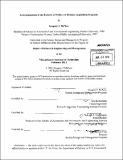An examination of the patterns of failure in defense acquisition programs
Author(s)
McNew, Gregory J
DownloadFull printable version (24.48Mb)
Other Contributors
System Design and Management Program.
Advisor
Eric Rebentisch.
Terms of use
Metadata
Show full item recordAbstract
The history of acquisition reform dates back to the Revolutionary War era, and recommendations and actions to reform the Department of Defense's acquisition system continue today. Common themes emerge from the recommendations of countless Acts, Studies, Panels, and Commissions over the past 30 years, pointing to areas that appear to have the most impact on the system. Despite these actions and recommendations, issues remain at the program execution level, resulting in increased cost and delays in fielding needed capabilities. This work focuses on three areas. A comprehensive Literature Review of acquisition reform activities was conducted. This generated a list of common themes and focus areas that are associated with less than successful program outcomes. Following this, a series of ten patterns of behavior (acquisition archetypes) postulated for software programs developed by Carnegie Mellon University's Software Engineering Institute were examined for applicability to the larger Department of Defense acquisition system and to determine their relationship to acquisition reform actions. As part of this effort, a survey of acquisition personnel was conducted to determine the relevance of these patterns of behavior. Based on these foundational works, the final step examined the results of the survey to answer four research questions. First, the survey results were analyzed to determine if the patterns of behavior were present with general and statistical relevance. The second question attempted to determine if the patterns of behavior led to measurable cost and/or schedule growth if they were present in the respondent's program. Third, the postulated root causes for the behaviors were compared to the common themes from acquisition reform activities to determine alignment. Finally, the survey results were analyzed to see if the patterns of behavior correlated to a particular program size, lead service, or "joint" program status. The findings show that the patterns of behavior are present in Department of Defense acquisition programs, and some do lead to measurable cost and/or schedule growth when identified. Acquisition Reform activities have been targeted at the areas that are reported as root causes of the behaviors, and one of the ten patterns of behavior does correlate with "joint" program status.
Description
Thesis (S.M. in Engineering and Management)--Massachusetts Institute of Technology, Engineering Systems Division, System Design and Management Program, 2011. Cataloged from PDF version of thesis. Includes bibliographical references (p. 213-217).
Date issued
2011Department
System Design and Management Program.; Massachusetts Institute of Technology. Engineering Systems DivisionPublisher
Massachusetts Institute of Technology
Keywords
Engineering Systems Division., System Design and Management Program.